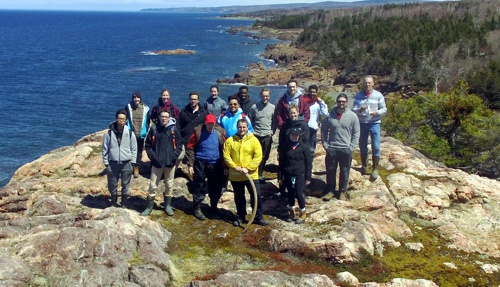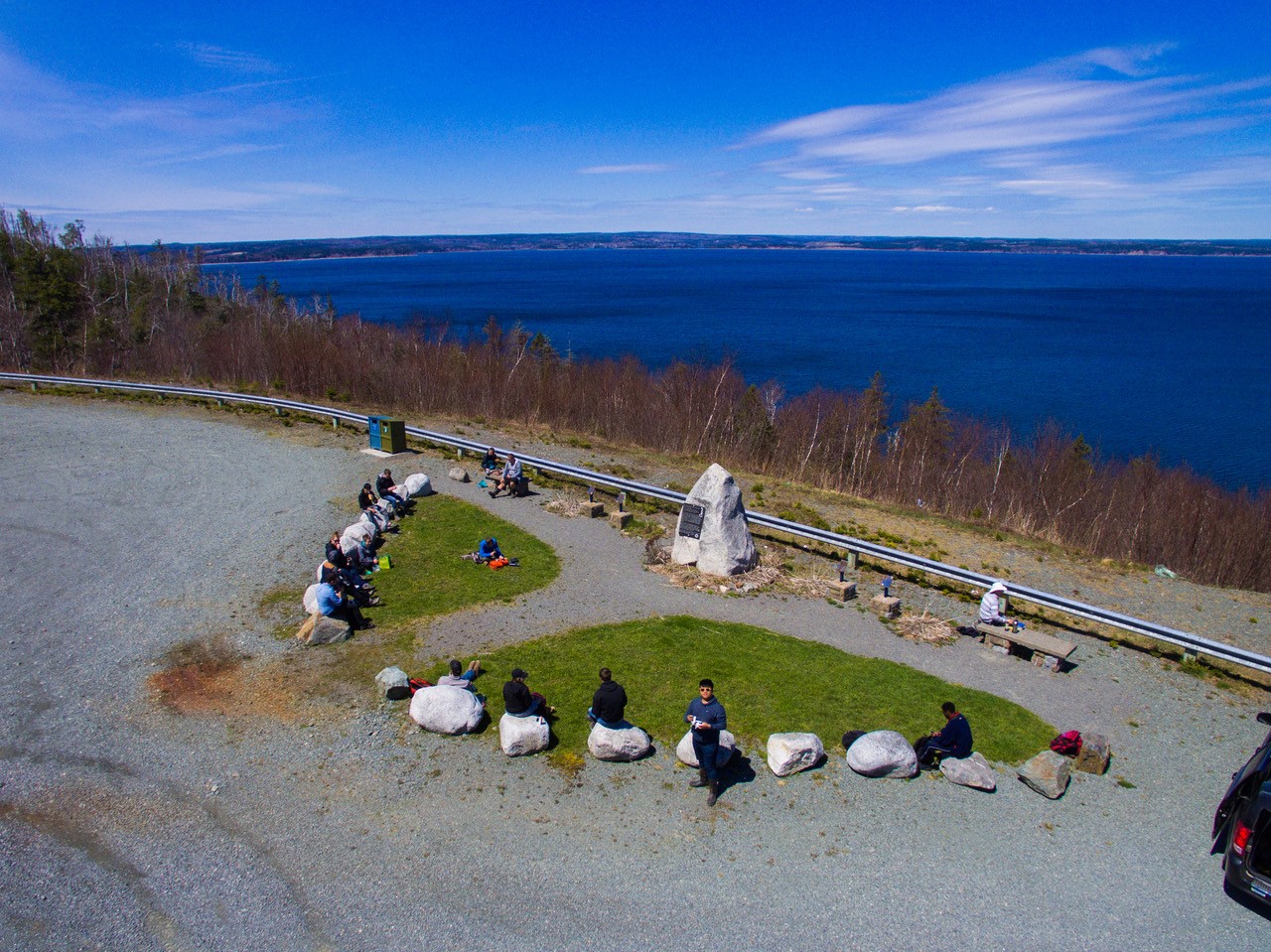Archive of news items - 2017
Deanne van Rooyen, adjunct professor, receives federal funding for work in Nunatsiavut
14 December 2017
As reported by Cape Breton University:
Dr. Deanne van Rooyen, Associate Professor of Geology at Cape Breton University and adjunct professor at Acadia has recently received federal research funding for a long-term research project that focuses on structural geology, geochronology, and tectonics. The $195,000 grant will be received over a two-and-a-half-year period and is part of a program from Natural Resources Canada, Geomapping for Energy and Minerals (GEM-2), which provides research funding to professors through the competitive Academic Grants and Contributions Program.
As a structural geologist who works in ancient mountain belts van Rooyen’s work focuses on how mountains evolve through time and how the oldest parts of Canada were formed. The funded project is located in Nunatsiavut, in the areas of Nain and Hopedale where two very old continents, the Hopedale block (3.2 to 2.8 billion years old) and the Saglek block (3.9 to 3.2 billion years old) are joined together. They are part of the North Atlantic craton, which used to contain what is now Greenland, bits of Scotland, parts of Scandinavia, and Labrador.
Van Rooyen’s research will focus on the Archean (older than 2.5 billion years) and Paleoproterozoic (between 2.5 and 1.8 billion years) parts of this history to determine the ages of rocks, the specific pressure and temperature conditions they record, and the ways that they interacted when they were all caught up in collisions between continents.

Deanne is also co-supervising two Masters theses at Acadia with Sandra Barr (Gabe Sombini dos Santos and Kyle Kucker) on her Cape Breton Island work, and supervised Acadia graduate Celine Porter for her Masters thesis at UNB on rocks in the Kuujjuaq area of Quebec.
Brent Murphy wins Industry Award for KSM Sustainable Development Program
13 December 2017
Seabridge Gold announced on 7th December that its Environmental Team won the 2017 Robert R. Hedley Award presented annually by the Association for Mineral Exploration in BC to a member company for significant contributions or advances in environmental management and/or social responsibility.
The award specifically recognizes the contributions of Seabridge’s Brent Murphy, Vice President of Environmental Affairs, and Elizabeth Miller, Manager of Environmental Affairs, who are leading the Company’s sustainable development program for its KSM Project. The program has pioneered community engagement, local development and environmental initiatives which were instrumental in obtaining approval of the project’s Environmental Assessment and have been widely recognized by representatives of the industry and the BC government.

Brent Murphy completed his Masters degree at Acadia in 1989 on mafic rocks in northern New Brunswick, and is now Vice President, Environmental Affairs at Seabridge Gold. He has presented seminars on his work in British Columbia to both the Geology and Environmental Science classes at Acadia.
Peter Ricketts' OpEd on State of the Oceans
12 December 2017
Dr. Ricketts, University President, and member of the Earth and Environmental Science Department recently attended the 23rd Conference of the Parties (COP23) to the UN Framework Convention on Climate Change (UNFCCC) in Bonn, Germany, where there was a series of events to promote the importance of oceans in the international dialogue and negotiations on global climate change. Following the conference he published an opinion piece in the Chronicle Herald entitled "The world’s oceans desperately need our help". The full article can be read on the Chronicle Herald website. He plans to do an expanded article for an upcoming publication on Oceans.
The Lighthouse Beach Study: A Collaborative, Student-led Environmental Assessment
21 November 2017
These students had the “job” working on a sunny white-sand beach through the month of August! Acadia student researcher, Baillie Holmes, worked alongside members of Pictou Landing First Nation to complete a preliminary environmental risk assessment of Lighthouse Beach (near New Glasgow, NS). The barrier beach is down shore from the outlet of Boat Harbour, a pulp mill waste-water treatment lagoon destined for remediation. As such, activities happening in Boat Harbour in the coming years have the potential to impact this barrier beach due to proximity and transport of material via shoreline currents.

The goal of this collaboration was to gather information regarding current and past social and environmental conditions of the beach. This included: how sediment accumulates and what effects this process, gathering an inventory of vegetation, shells and animals living on or around the beach, water quality testing in the lagoon, and consideration for community uses and value both historically and contemporarily. The report produced from the initiative will give the Boat Harbour remediation managers baseline information regarding beach conditions. Furthermore, this information sets the stage for more research at Lighthouse Beach by identifying what elements of the beach system warrant further study.
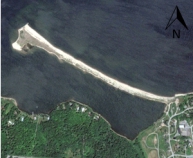
Cliff Stanley awarded Chayes Prize for Research in Mathematical Petrology
15 November 2017
Dr. Cliff Stanley recently became the recipient of the Chayes Prize for Excellence in Research in Mathematical Petrology, an award presented by the International Association of Mathematical Geoscientists at their 2017 annual meeting in Fremantle, Western Australia in September. Dr. Stanley is a leading expert in rock chemistry data analysis using matrix algebra and multi-dimensional projective geometry, and his research results have relevance in the mineral exploration, mining, and environmental milieu.
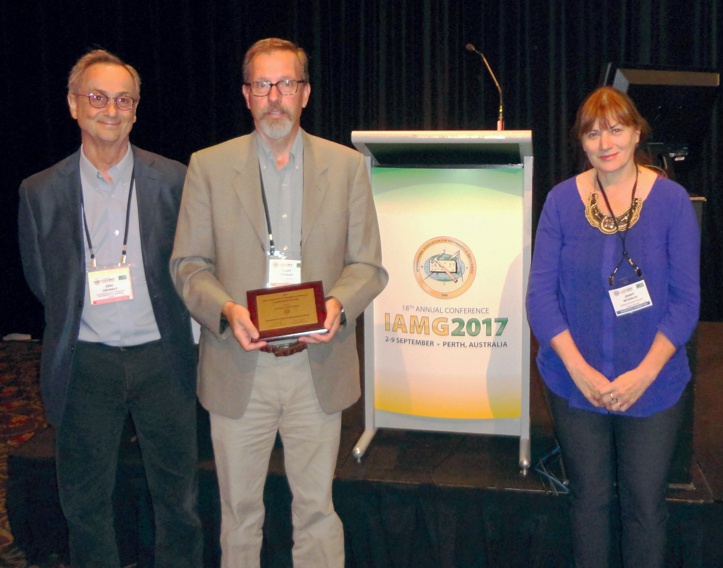
Pictured left to right: Eric Grunsky, Secretary General of the International Association of Mathematical Geosciences, Cliff Stanley, Jennifer McKinley, Queen’s University, Belfast, President of the IAMG.
Sarah Dunn at the Clastics Exploration Field School in Calgary
9 November 2017
Sarah Dunn, MSc candidate, attended the Clastics Exploration Field School from October 16th to 20th. This was a 5-day intensive course run by Dr. David James, and sponsored by the CSPG.
The course was hosted at the AER Core Research Facility in Calgary. Attendees were exposed to over 600 boxes of core during the week. The program focused on core description, identification of sedimentary structures, recognition of potential reservoir facies, and sequence stratigraphy. Emphasis was placed on using first principles and "thinking geologically". A combination of lecture, geophysical logs and core examination was used to solve correlation problems from the Western Canadian Sedimentary Basin. This was an invaluable experience and has without doubt improved her core-logging skills in preparation for core analyses of the clastic-chemical suites which will constitute a part of her field work in the summer of 2018 in North Wales.
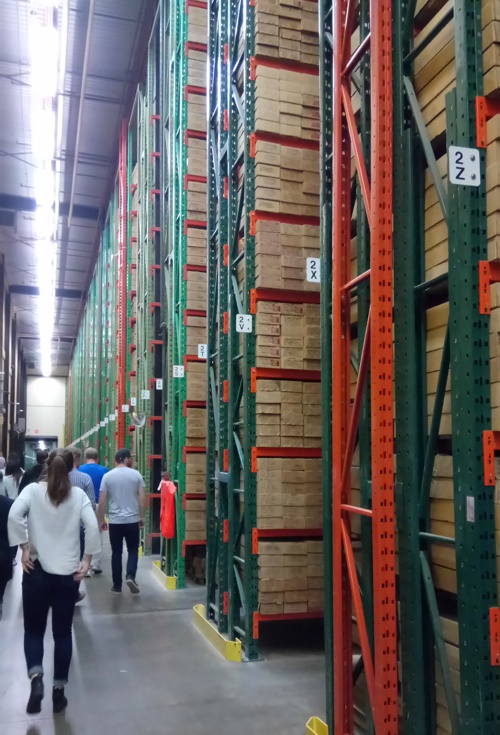
Inside the Core Labs in Calgary.
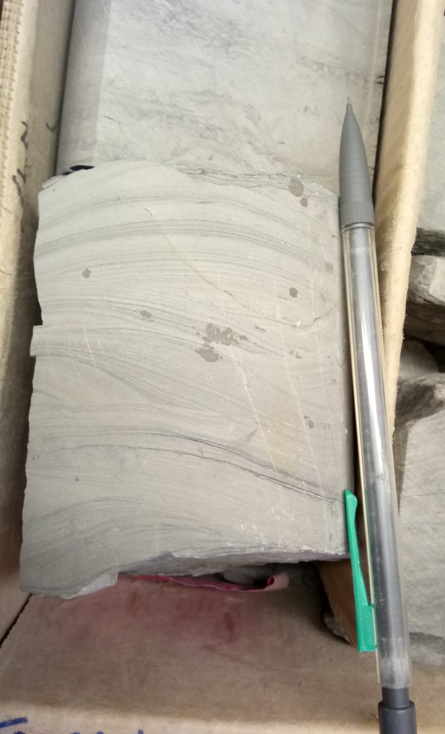
Cross-bedded arenite. Quick now - is the box upside-down or right way up?
AUGC 2017 in Newfoundland
30 October 2017
The 67th annual AUGC (Atlantic Universities Geoscience Conference) was held at Memorial University on 26-28 October, 2017. The mandatory George St. event was held on Thursday evening, so participants are to be congratulated on turning up as early as 7.30 next morning for field trips to Mistaken Point and to Epithermal Gold Deposits in Holyrood. The weather cooperated with reports of teeshirts all that was needed at Mistaken Point (surely a rare event any time of year!) The CSEG Challenge Bowl ran in the University Centre, with teams from each university participating. The Acadia team consisted of all four attendants (Max Chipman, Kirklyn Davidson, Baillie Holmes, Heather McGuire), who aced the first round and came in fourth in the final round. The expected screech-ins (with pizza) ran along-side the Challenge Bowl.
On Saturday morning, students presented their work both in talks and on posters. The usual high quality was maintained. Presenters for Acadia were Kirklyn Davidson, looking at "Spatiotemporal assessment of metal concentrations of pre-effluent estuarine sediments in a freshwater kraft pulp mill tailings pond using paleolimnological methods", Heather McGuire, giving "A paleolimnological approach to understanding metal retention and mobility associated with salt-water intrusion inundation at Laytons Lake, Nova Scotia", and Max Chipman, discussing "The bountiful coprolites of the Joggins Formation." Congratulations to all three presenters who did a great job, and special note to Kirklyn, who won the AGS Environmental Geoscience Award, and Max, who won the Canadian Society of Petroleum Geologists Award for best presentation of a petroleum geology-related paper.
All the winners were present for the closing banquet, where John Jamieson (MUN, proud to have been rejected as a Canadian astronaut applicant) regaled us with advise about how to succeed.
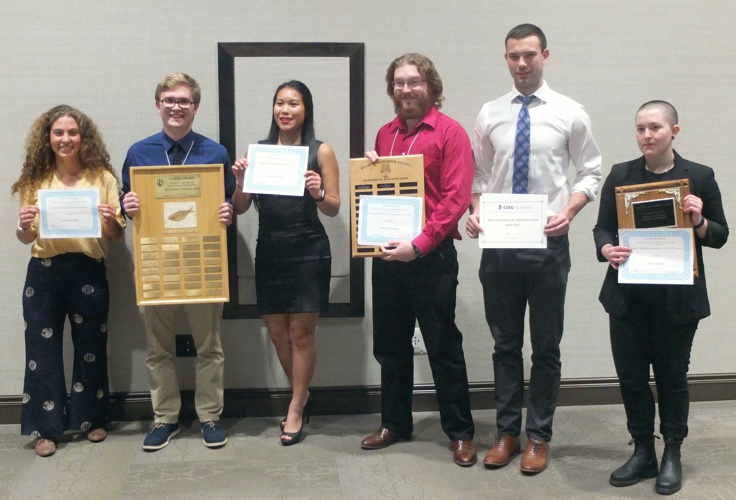 Winners of awards at the AUGC (left to right):
Winners of awards at the AUGC (left to right):
Ariel Greenblat, Dalhousie University (Science Atlantic Presentation and Communications Award);
Max Chipman, Acadia University (CSPG Award);
Mariah Williams, St. Mary's University (Imperial Oil Best Poster Award);
Kirklyn Davidson, Acadia University (AGS Environmental Geocience Award);
Joey Pittman, Memorial University (CSEG Award);
Kate Woods, Dalhousie University, (Frank Shea Award).
Acadia students at IMS 2017, Toulouse, France
25 October 2017
Stephanie Todd and Nabil Shawwa presented the results of their M.Sc. thesis research at the 33rd International Meeting of Sedimentology in Toulouse, France, October 10 to 12. The IMS is the largest annual gathering of sedimentologists from around the world. Stephanie’s thesis is supervised by Dr. Peir Pufahl and focuses on the paleo-oceanography of Ordovician ironstone from Bell Island, Newfoundland. Nabil is an E&ES alumnus and completed his M.Sc. on the climate record preserved in Carboniferous exposure surfaces in Spain at the University of Geneva under the direction of Dr. Elias Samankassou.

Reunion 2017
23 October 2017
Twenty years after graduation this foursome is still going strong, back at Acadia to catch up with each other and check that standards remain high at Acadia. Although they dropped by the Structural Geology lab, they deferred on showing off their stereonet skills, and instead located the Fletcher Club arms (just leave it there, guys!) After their visit to the department, there was some talk of searching for a glass item to see if it showed any evidence of devitrification...

Left to right: Scott Lister, Jason James, Bob Barter, Jonathan Gunstrom
Geology of Nova Scotia makes the "Libraries 150" List of Books of Influence in Nova Scotia
2 October 2017
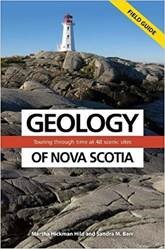 The Geology of Nova Scotia Field Guide: Touring Through Time at 48 Scenic Sites, co-authored by Martha Hickman Hild and Acadia's Sandra M. Barr, made the list of 150 Books of Influence compiled by the Nova Scotia Library Association and Nova Scotia's nine regional public library systems in honour of Canada's 150th birthday. The titles on the list are those books that have captured Nova Scotians' hearts and minds; books that tell Nova Scotia's stories and inspire its citizens. Canada's 150th Anniversary is a perfect opportunity to examine and consider those books which reflect our current state as a people and province, as well as books that mark our progress over the decades since Confederation. Also on the list is "The Last Billion Years", published by the Atlantic Geoscience Society. It is good to see geology in the public eye in a positive way, not just natural disasters!
The Geology of Nova Scotia Field Guide: Touring Through Time at 48 Scenic Sites, co-authored by Martha Hickman Hild and Acadia's Sandra M. Barr, made the list of 150 Books of Influence compiled by the Nova Scotia Library Association and Nova Scotia's nine regional public library systems in honour of Canada's 150th birthday. The titles on the list are those books that have captured Nova Scotians' hearts and minds; books that tell Nova Scotia's stories and inspire its citizens. Canada's 150th Anniversary is a perfect opportunity to examine and consider those books which reflect our current state as a people and province, as well as books that mark our progress over the decades since Confederation. Also on the list is "The Last Billion Years", published by the Atlantic Geoscience Society. It is good to see geology in the public eye in a positive way, not just natural disasters!
River Rafting and Sandbar Soccer
25 September 2017
Sunny and warm weather on the first weekend of fall was perfect for a couple of activities for Earth and Environmental Science students along the shores of the Minas Basin. On Saturday, a small group headed out to Rainy Cove to join students from the Dalhousie petroleum geoscience course, led by Grant Wach (Dal) and Carla Skinner (Shell, Calgary). At low tide they ventured out to the giant sand bar to examine the megaripples developed there.
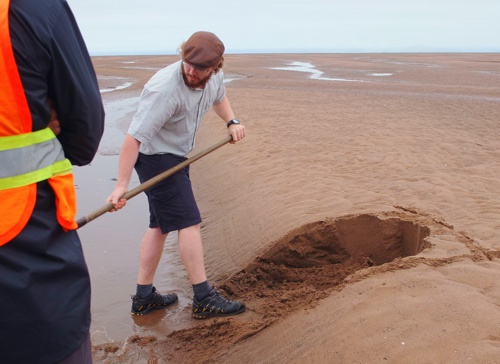 Kirklyn excavating a trench in a megaripple to examine the sediment build-up, calculated to have formed over the course of three months, based on coarser grained layers deposited during spring tides.
Kirklyn excavating a trench in a megaripple to examine the sediment build-up, calculated to have formed over the course of three months, based on coarser grained layers deposited during spring tides.
Returning from the sandbar, the group crossed a broad channel, scoured free of sand by the tidal currents. What better place is there for an Acadia-Dalhousie soccer game?
 Alex on the ball, about to pass to Kirklyn, who forwarded it to Sarah to score the first goal. Acadia up 1-0 after 2 minutes. We won't say anything more about the next 4 goals scored by Dalhousie, except that they did have some of the Dal soccer team playing for them. Game was cut short at 25 minutes by incoming tide.
Alex on the ball, about to pass to Kirklyn, who forwarded it to Sarah to score the first goal. Acadia up 1-0 after 2 minutes. We won't say anything more about the next 4 goals scored by Dalhousie, except that they did have some of the Dal soccer team playing for them. Game was cut short at 25 minutes by incoming tide.
Back at the cliffs, Grant Wach expounded on the similarities between tidal sand bars in the modern environment and Triassic fluvial sandstone and conglomerate deposits:
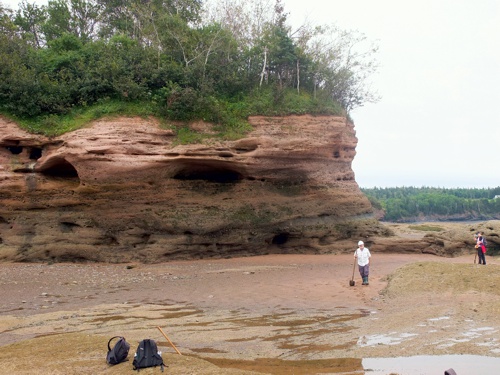
Finally the group encountered the famous Triassic angular unconformity at Rainy Cove:
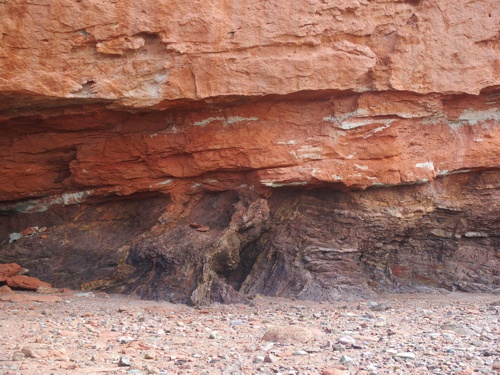
On Sunday, another group ventured along to Maitland to experience the tides up close, rafting on the tidal bore. clearly they also encountered sandbars, waiting for the tide to come in:
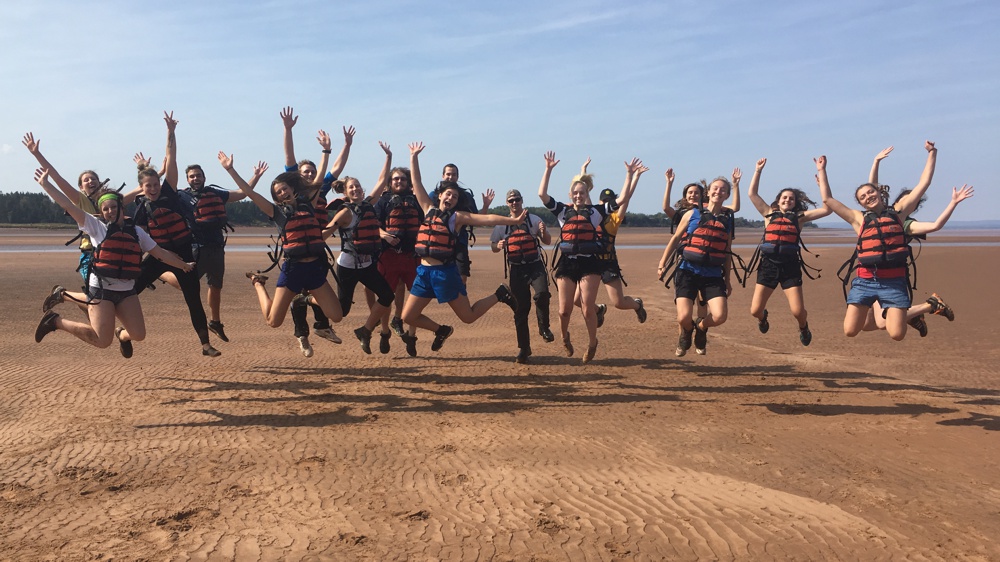 [Click on image for larger version.]
[Click on image for larger version.]
Much fun was to be had getting dirty in the mud along the river banks:

[Click on image for larger version.]
Finally, the tidal bore arrived and everyone got cleaned off:
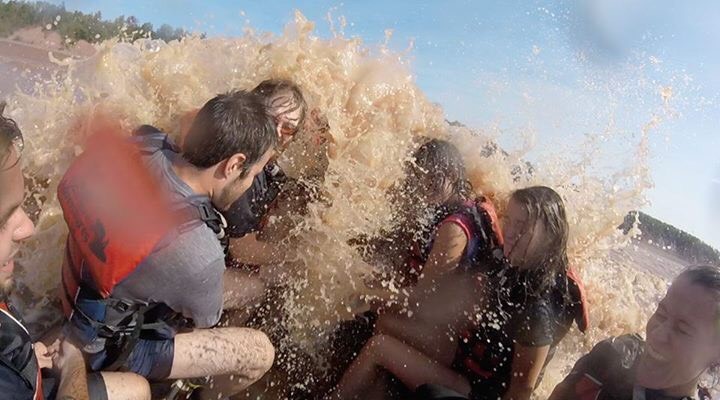
[Click on image for larger version.]
ESSA and Fletcher Club get out of Wolfville
10 September 2017
The first weekend of term - a great chance to get out of town before homework accumulates!
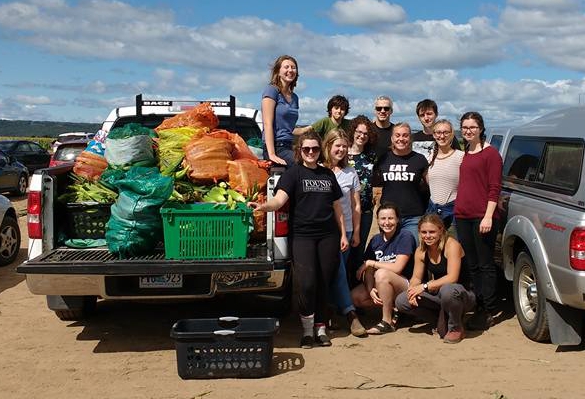
Students in ESSA (Environmental Science Students Association) took the chance to go gleaning. Taproot Farms called for corn harvesters and they answered! They had a blast picking corn for donation to Found Forgotten Food NS. These trucks are off to food banks and soup kitchens all around Nova Scotia. Thanks to all our raw corn munching ESSA volunteers! Look out for more harvesting opportunities to come!
Meanwhile, the Fletcher Geology Club went hiking.
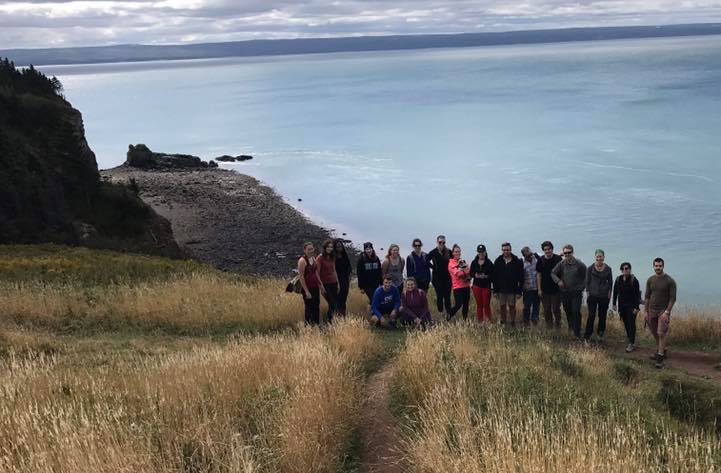
At Cape Split - the grey early morning start turned into a fine day as students enjoyed the clifftop views from the cape.
Acadia geoscientists weigh in on Falmouth sinkhole story
6 September 2017
Peir Pufahl and Ian Spooner (Acadia University Earth and Environmental Science) and Deanne van Rooyen (Cape Breton University - Adjunct Acadia E&ES) were all consulted on the sinkhole that destroyed a home in Falmouth Nova Scotia Sunday September 3rd. The print and radio media was interested in learning about the geological conditions that might have led to the development of the sinkhole and the measures that might be taken to identify susceptible areas.
You can read I. Spooner’s and Bob Ryan’s (NS Dept of Natural Resources) comments on the following link: thechronicleherald.ca
P Pufahl’s and D. van Rooyen’s comments can be read at: www.cbc.ca
Is Huggins ready for classes?
5 September 2017
Here are some shots around Huggins on the day before classes (early morning shots - a lot will change today!)
View from the southwest:

Offices have been rebuilt, new insulation (no gaps between floors in the overhangs now will surely mean warm feet this winter!) The toilet block on the second floor is still unchanged to provide a before-and-after view.
View from the east:
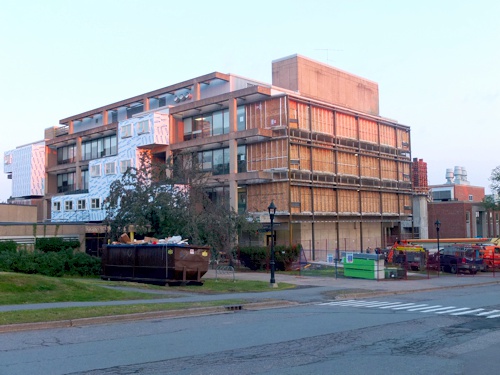
Sunrise brightens the attractive chipboard paneling erected just last week, presumably to prevent students from falling off the corridors. Still quite a bit of work to be done here - the windows are all neatly stacked in the main foyer, waiting to go in.
Inside - one of the offices:

Dr. McMullin's office appears to be finished - window in, carpet down, carpentry complete. No furniture, though. I wonder if he will move the red squares around for a change of scenery?
Main office:
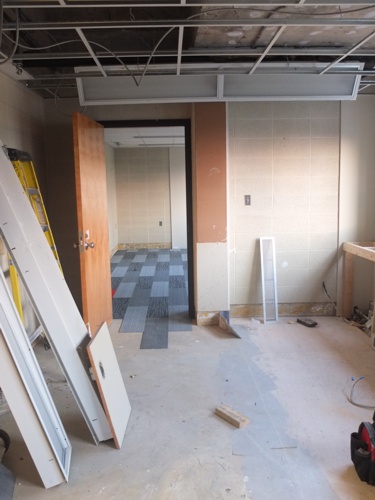
The view from Mrs. Graves' office through to Dr. Spooner's office. This one will take a bit of time to get finished! In the meantime, Mrs. Graves can be located in HSH 304 and Dr. Spooner in 316.
Student lounge:
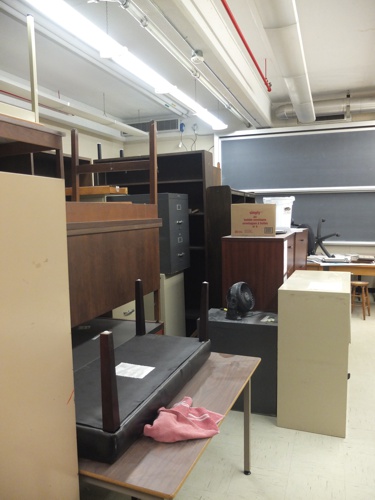
So where did all the stuff go? Into the student lounge! Maybe we will have to use an hour of the first lab to restock the classrooms and offices!
Senior field school in Cape Breton Island
29 August 2017
The senior field school is now well under way in Cape Breton Island. Students have been busy wading streams, discovering the complex geology, and enjoying the perfect weather (so far!)

First day, first outcrop, on the lip at Limestone falls. What are we supposed to do here?
Getting into the swing of things - examining the huge gypsum outcrop on Goose Cove Brook. This outcrop has really grown over the years as the river has swept away the talus that used to bury the bottom 15 m of it. Now we can see a basal shear zone with duplex structures and S & C fabrics!
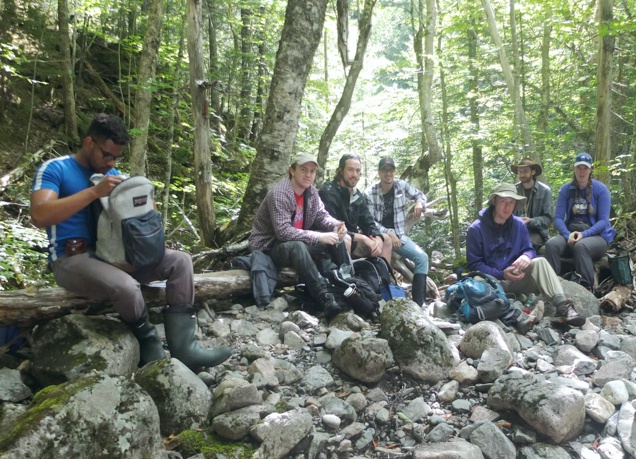
Lunch on Day 1 in Goose Cove Brook.
Progress in renovations to Huggins
18 August 2017
The last few weeks have seen considerable progress in the renovations of Huggins Science Hall. The offices that were demolished in July all have spanking new insulation and windows are back in. We all wait eagerly to see the final job!
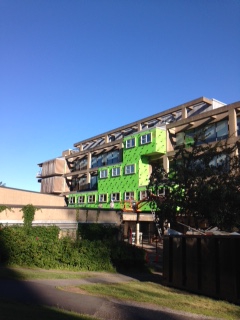
Brendan Vibert swimming the Northumberland Strait
4 August 2017
The Advertiser reports that a "Wolfville swimmer [is] excited to take the challenge of Northumberland Strait with The Big Swim". Final year Geology major, Brendan Vibert, will tackle the swim from Cape Jourimain, N.B. to Borden-Carleton, P.E.I., on Sunday morning, 6 August. Brendan is co-captain of Acadia’s varsity team but still considers the 15 km swim to be a challenge. He was inspired to participate to support a friend, and by Jackson Malone who has participated by kayak twice before. Funds raised through the event go to support Camp Brigadoon on Aylesford Lake. The E&ES department is contributing to Brendan's fund-raising effort.
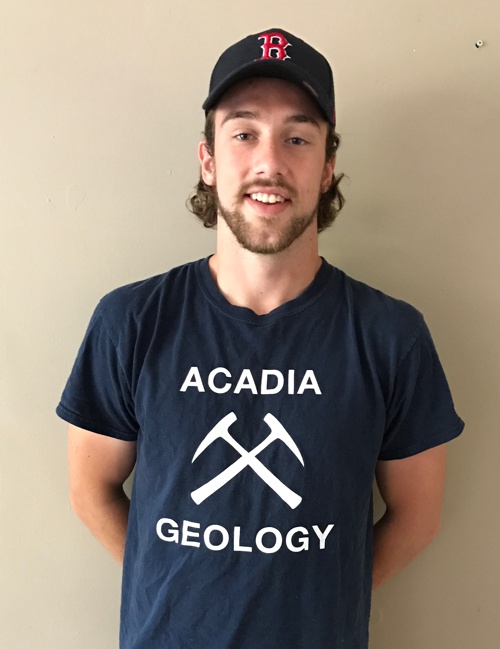
Roger Tomlinson thesis available to download
19 July 2017
Roger Tomlinson was a member of the class of 1960 and at one time taught physical geography at Acadia. After he left Acadia he made a career in the field of geographic information systems (GIS) - hence the attribute "Father of GIS". Shortly after his graduation, while working in Kenya, Roger conceived of the need for overlapping but integrated mapping of forests, and he later developed this into the geographic information systems we know today.
Dr. Tomlinson had a varied career, working from Ottawa on projects as diverse as the realignment of the Alaska Highway, forestry practices in Canada, USA, Africa, and landscape changes in the Brazilian rain forest. He received the Gold Medal of the Royal Canadian Geographical Society, a place in the GIS Hall of Fame, and was appointed as a Member of the Order of Canada. In 2008 Acadia awarded him with an honorary degree.
"The Application of Electronic Computing Methods and Techniques to the Storage, Compilation and Assessment of Mapped Data" shows how the pioneers of GIS were thinking over 40 years ago.
Construction work around Huggins
12 July 2017
Construction continues apace in the renovations of Elliott and Huggins Halls. Over the past 3 weeks, we've watched the roof getting replaced on Elliott, a parade of benches and fume hoods lined up to go in the building, the windows of the offices removed in Huggins and on-going construction for the new Innovation Pavilion between Huggins and Elliott.
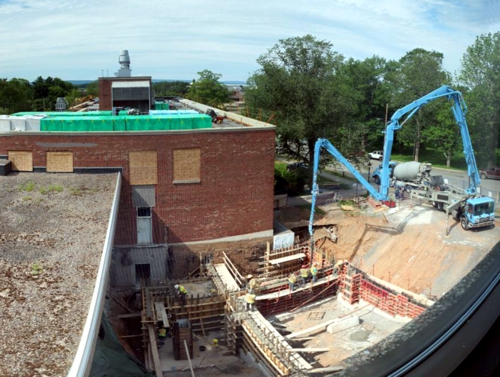
Today it was time to pour the concrete for the basement level walls in the Innovation Pavilion.
Huggins Exposed!
21 June 2017
Renovations have begun on Huggins Science Hall in order to provide it with a better outer structure. The east wall has now been removed to be replaced by insulated walls and windows. As the wall was being taken out, we were all surprised to discover that no insulation existed between interior cinder blocks and the exterior concrete shell. No wonder the end corridors got so cold in winter!
Before:
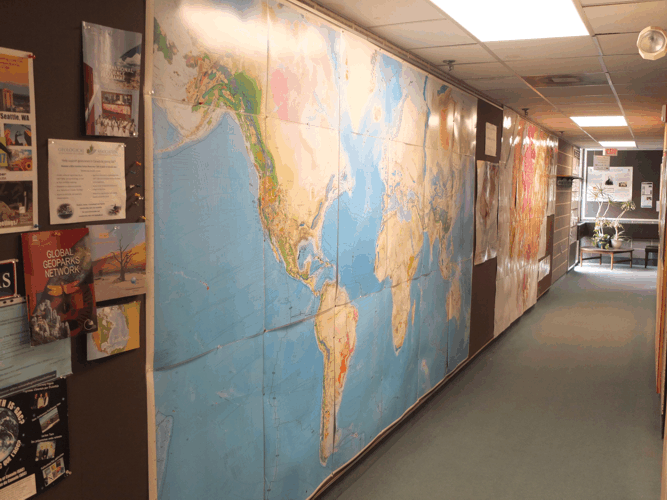
And after:
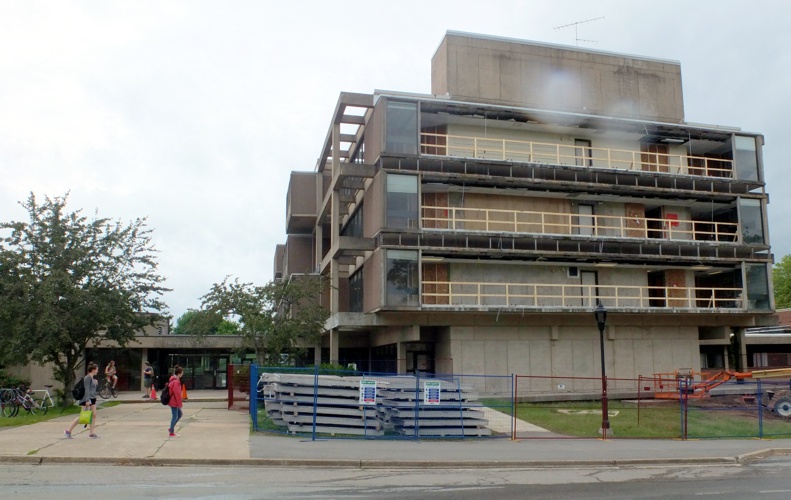
Summer Assembly E&ES Awards
15 June 2017
Congratulations to Dr. Robert Raeside on receiving his 35 Year Service Award from President and Vice-Chancellor Ray Ivany at the Summer General Assembly, 15 June 2017. Also, we congratulate Dr. Nelson O'Driscoll on receiving his 10 Year Service Award at the Assembly. Congratulations Rob and Nelson!!
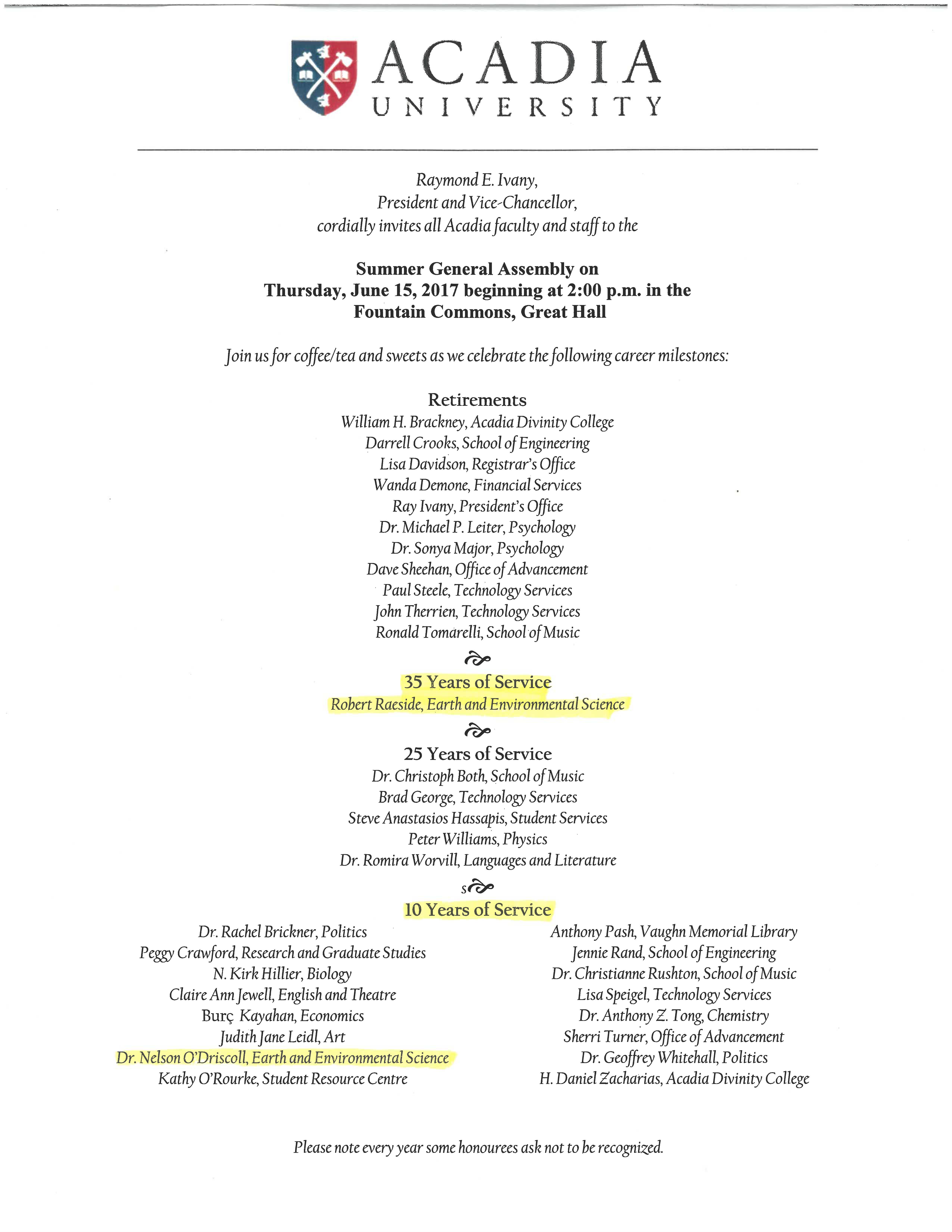
CFI Catalyst Study on Acadia Centre for Analytical Research on the Environment (CARE)
2 June 2017
The Canada Foundation for Innovation (CFI) has introduced a new way to examine the impacts of its funding. A “catalyst study” aims to assess the overall impact CFI investments at one institution have had in a particular research area. For the first study of this kind, they looked at Acadia University’s Centre for Analytical Research on the Environment (CARE), which provides researchers with advanced equipment to study and measure trace levels of contaminants in the environment.
The CFI funded five environmental research projects at Acadia through the John R. Evans Leaders Fund. By bringing the infrastructure from each of those projects together under one roof to form CARE, a small university has had a big impact in environmental studies. The Centre has attracted researchers to form a multidisciplinary group of scientists, which has helped the institution secure collaborations nationally and internationally and solidify its reputation as a hub with expertise in environmental research and training.
READ: A catalyst study: Acadia Centre for Analytical Research on the Environment (CARE)
This case study demonstrates how five awards through the Canada Foundation for Innovation’s John R. Evans Leaders Fund have helped to position Acadia University as a leader in environmental sciences. It also indicates that CFI has played an important role in enabling the creation of an internationally competitive research centre for a relatively small CFI investment.
These awards have had a catalytic effect on the capacity and dynamism of Acadia’s Centre for Analytical Research on the Environment (CARE). Through strategic use of its CFI funding envelope, Acadia University has been successful in attracting and retaining top research talent in environmental sciences and has created an environment that continues to perpetuate this priority.
Dillon Langelaan at SIFT in Calgary
29 May 2017
Dillon Langelaan represented the Acadia Geology program at the annual Student-Industry Field Trip in Calgary in May 2017. Selected by the Department and by the sponsoring organization, CSPG, Dillon participated in a two-week expenses-paid trip to Calgary where he learned about the ins and outs of the energy industry. He took part in visits to corporate headquarters downtown, lectures at the University of Calgary, site visits to a gas processing plant and to the Drumheller Badlands, a four-day field trip through the Rockies, and through it all competed in the Exploration Game - a high stakes mock-up of exploration and production from an oilfield in Alberta. Starting with $25 million, Dillon's team bought and sold drilling rights, hired drilling teams, analyzed the results, and in the end increased their investment to $27.5M, enough to win the Larry Strong Financial Award (and the only team not to lose money in the exercise!)
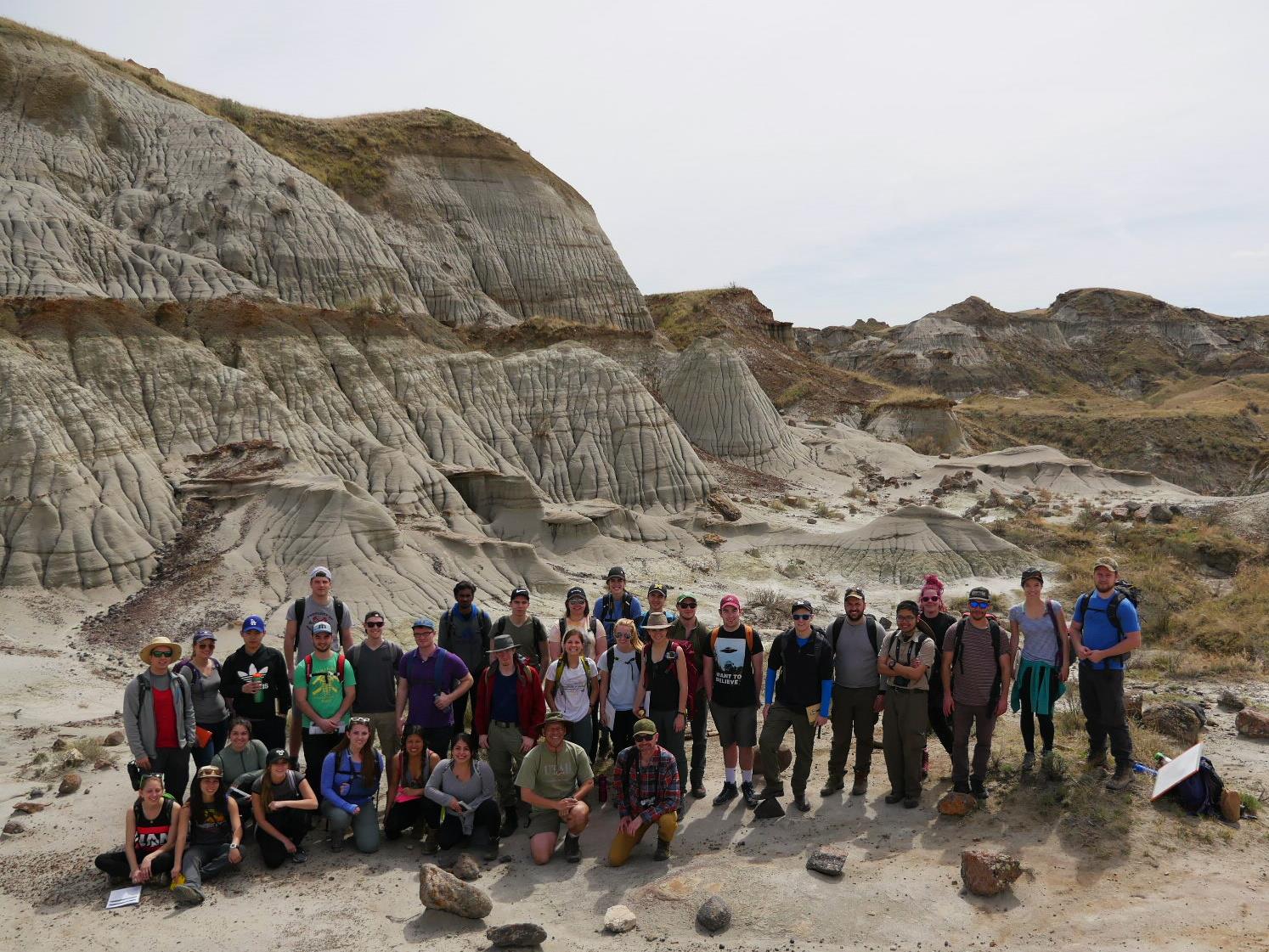
SIFT participants at the Badlands, Red Deer River, Alberta

At work in the Core Lab

On the Rocky Mountains field trip

SIFT students at the University of Calgary

Winners of the Larry Strong Financial Award
Dillon dropped by the department when he was home in Nova Scotia briefly following SIFT, and before embarking on work as a field technician with Ground Truth Exploration in Dawson City, Yukon.
CSEG Challenge Bowl
18 May 2017
The first round of the Challenge Bowl was at the AUGC in October, and as a result of their outstanding participation then, two Acadia teams participated in the annual CSEG Challenge Bowl at the Geoconvention in Calgary on 17 June. Dillon Langelaan and Simon Poirier made up one team, and Sarah Dunn and Don Raeside the second team. In total 12 teams participated from across the country. Sarah and Don took second place behind the University of Manitoba, and Dillon and Simon placed 6th.
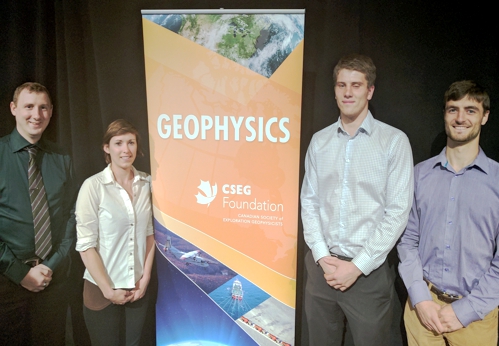
Don Raeside, Sarah Dunn, Dillon Langelaan, Simon Poirier at the CSEG Challenge Bowl in Calgary.
Graduation 2017
16 May 2017
34 Graduates in Earth and Environmental Science at May Graduation
In spite of the overcast and drizzly weather, spirits were high as graduating students and proud family members attended the graduation ceremonies at Acadia University. In all, 32 BSc degrees and 2 MSc degrees were recognised from Earth & Environmental Science at the May convocation at Acadia, comprising 1 MSc (Geology), 1 MSc (Applied Geomatics) 3 BSc Honours (Environmental Science), 3 BSc Honours (Geology), 16 BSc (Geology), 8 BSc (Environmental Science) and one BSc (Geology/Environmental Science double major). In addition, two graduates from last year had their degrees converted to honours, following their completion of a thesis over the past year.
Particular honour went to Sarah Fancy, winner of the University Medal in Environmental Science, and Sarah Dunn, winner of the University Medal in Geology and recipient of the Mining Society of Nova Scotia Centennial Medal.
 E&ES graduates are pictured somewhere in here (screenshot from the live broadcast of the Convocation)
E&ES graduates are pictured somewhere in here (screenshot from the live broadcast of the Convocation)
15 Environmental Science students complete field school
10 May 2017
The Environmental Science field school recently completed with 15 students engaged in a variety of multidisciplinary hands-on field exercises. Students gained practical experience in the areas of forest ecology, entomology, environmental analytical chemistry, quality assurance in field sampling, coastal biogeochemistry, coastal wetland delineation, mycology and much more.
 Lunch under the forest canopy.
Lunch under the forest canopy.

Philicity and Hannah prepare to analyze core.
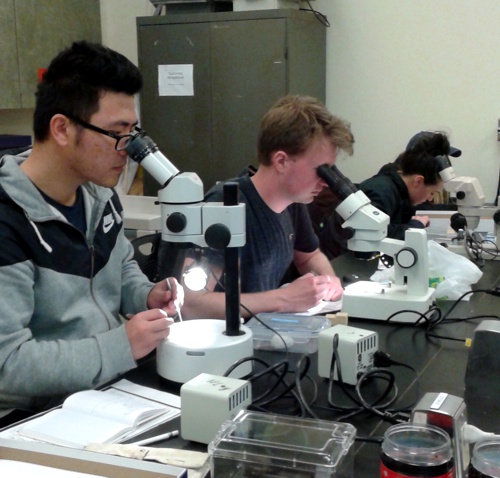
Elvis and Nathan do a bit of picking under the microscopes.
Checking out the ecology on the marshes.
Acadia Geology field course in Bermuda
8 May 2017
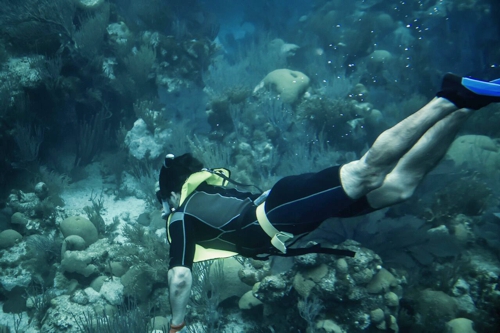 Exploring the reef (image by Reid Cameron)
Exploring the reef (image by Reid Cameron)
Geology field school relocates to Camp Geddie
6 May 2017
Having completed 5 days of field work near Wolfville, the Geology field school students travelled to Camp Geddie on the North Shore of Nova Scotia, near Merigomish to continue mapping exercises.
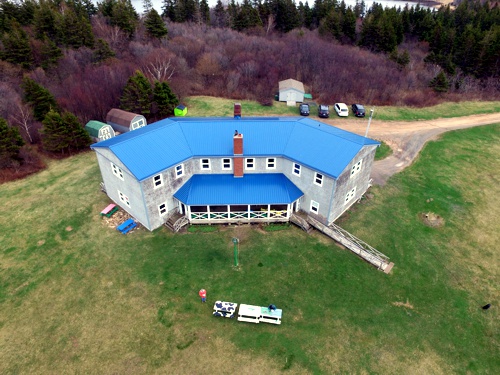
Camp Geddie is located on the shore of the Northumberland Strait and provides a home away from home for the week. After an introductory lecture on note taking and the local geology, students retired to the lawns to admire the views over to Pictou Island.
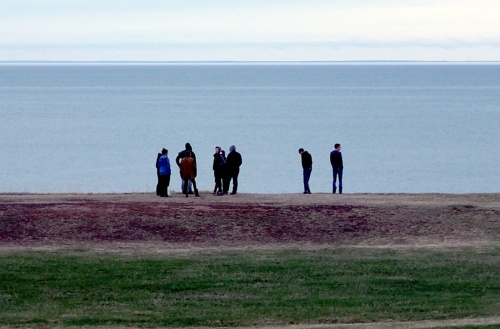
A drone's view of Camp Geddie between the Ponds [photo by Anthony Chu].

And a look along the shore at the barachois beaches and ponds [photo by Anthony Chu].
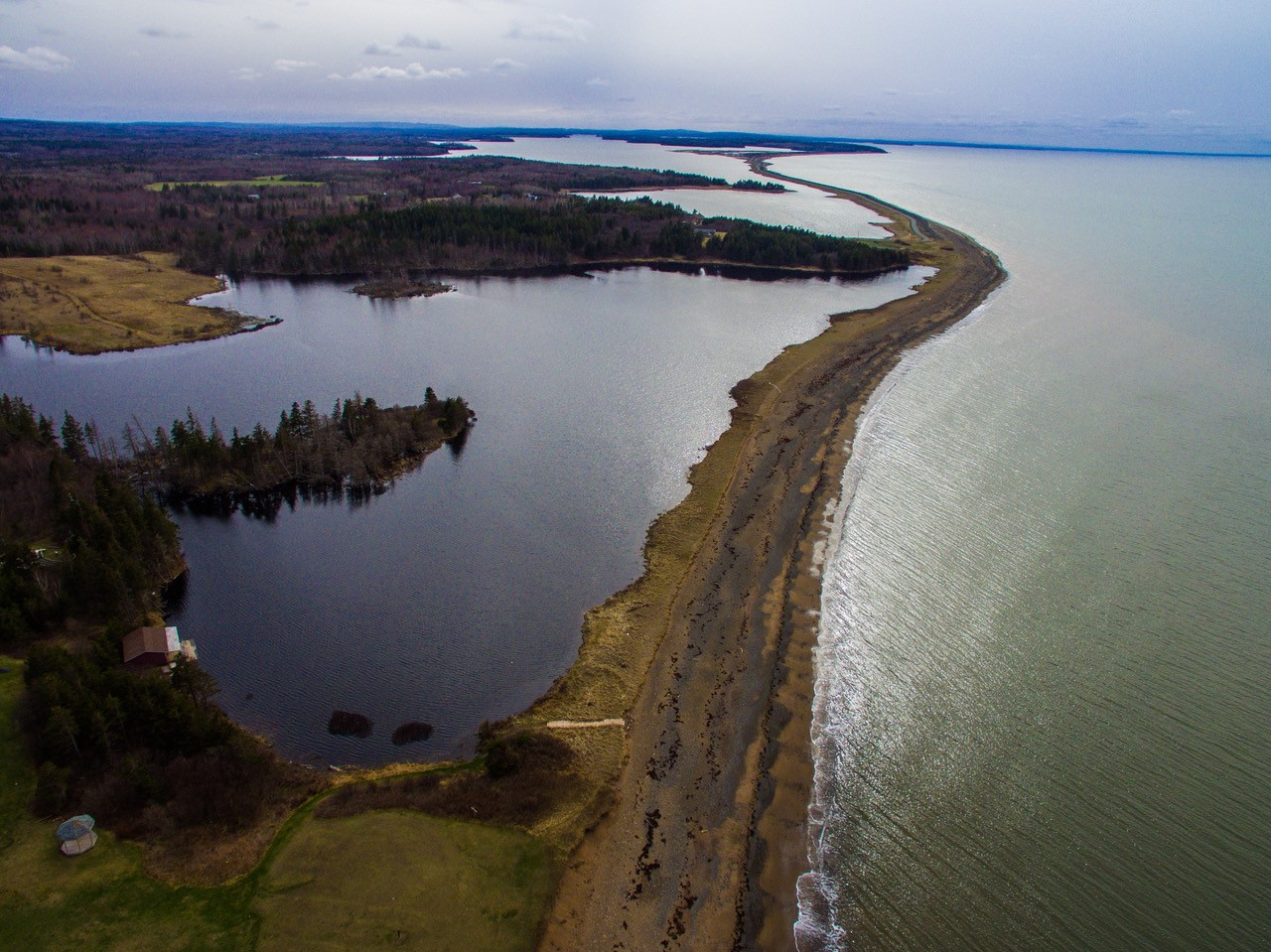
Click on image for larger version
Serious work started on Tuesday with a visit to the Georgeville shore. Want to see more drone photos of the outcrops you worked on in years gone by? Here is a selection:
Alaskite headland at Georgeville - zoom in to see faces on quartz crystals and bobfergusonite patches - mineralogy by drone!
Devonian dykes at Georgeville - zoom in to see the xenoliths, reddened margins, cross-cutting faults
Basaltic islands at Arisaig (image by Anthony Chu)
East beach at Arisaig (image by Anthony Chu)
Rhyolite hill at Arisaig (image by Anthony Chu)
Field school class on the Arisaig exercise with Dr. McMullin on drone control. Click on image for larger version.
Lunch stop at the Henry Sinclair monument on the Cobequid-Chedabucto Fault Zone near Guysborough. Image by Anthony Chu.
Second-year field schools under way
26 April 2017
Thirty students have embarked on the Environmental Science and Geology field schools. Brisk, but sunny weather greeted participants on the first couple of days, here at the glass sand outcrop in Fall Brook quarry.

After three days learning the techniques of geological mapping, the group will split, with the Environmental Science majors participating in a wide variety of exercises in the biological and ecological realms, while the Geology majors will continue with more complex geological exercises both locally and on the North Shore of Nova Scotia near Merigomish.
ASU Leadership in Teaching Award to Rob Raeside
12 April 2017
Every year the Acadia Students Union hosts a celebration of activities for the year, which this year included a Leadership in Teaching Award to Rob Raeside "in recognition of valuable contributions to the academic life of students at Acadia University". In making the award, Environmental Science honours student Maggie MacDonald noted "Thank you for your time, your guidance and advice, and your patience. There has been zero problems that you could not help fix. The students of Earth and Environmental Science are so lucky to have you."

Acadia students participate in the Ritual of the Calling Geoscience Ring Ceremony
11 April 2017
Seven Acadia Geology graduates participated in a ceremony held at the Dalhousie Faculty Club on April 7 to receive their sterling silver ‘Geoscience Rings”.
 From left to right: Nathan McCullough, Brooklyn Heron, Dillon Langelaan, Erik Petersen, Percy Clark, Kenneth Okoro, Patrick Smith
From left to right: Nathan McCullough, Brooklyn Heron, Dillon Langelaan, Erik Petersen, Percy Clark, Kenneth Okoro, Patrick Smith
GAC and MAC prize winners, 2017
10 April 2017
The recipients of prizes awarded by the Geological Association of Canada and the Mineralogical Association of Canada were recently announced.
The GAC prize is awarded to an undergraduate student who is "academically sound, has good leadership skills (e.g. as they pertain to organizing field trips, geology-club events, etc.), and has done well at field school or otherwise shown proficiency in field techniques." The winner for 2017 is Erik Petersen.
The MAC prize is awarded to the student who has achieved the highest standing in courses in mineralogy and petrology. This year the MAC moved the date of the award of the prize from May to January, so we have two recipients in the past year. In 2016, Jackson Malone received the award; in 2017 it is Nathan McCullough.
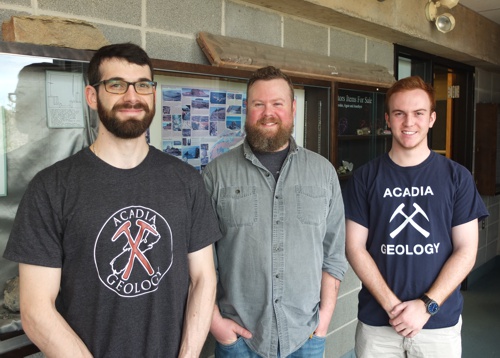 From left to right: Nathan McCullough, Erik Petersen, Jackson Malone.
From left to right: Nathan McCullough, Erik Petersen, Jackson Malone.
Sarah Dunn NSERC CGS-M awardee to study Welsh ironstone
5 April 2017
Sarah Dunn NSERC CGS-M awardee to study Welsh ironstone
Congratulations to Sarah Dunn, recipient of a NSERC CGS-M! This prestigious graduate scholarship is awarded to an outstanding undergraduate student entering their first year of a MSc program. Sarah will begin her graduate program next fall under the supervision of Dr. Peir Pufahl. She will investigate the deposition of Welsh ironstone to understand the relationship between the marine iron cycle and Ordovician ocean evolution.
Year-end potluck dinner, 2017
3 April 2017
ESSA and the Fletcher Club held their combined year-end potluck dinner in the Wolfville Curling Club on 31 March. Students and professors gathered to celebrate the year almost done, and enjoy sampling each others' cuisine.
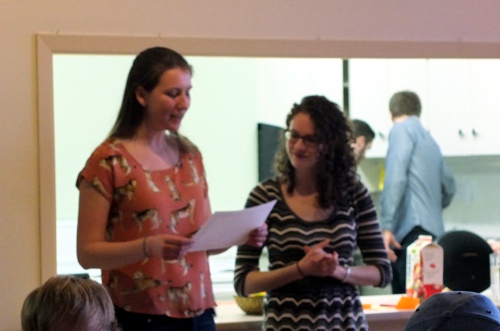
Organized by the Environmental Science Student Association, Baillie Holmes and Rachel Clarke (above) arranged for geo-games, door prizes, and awards for other department members. The Fletcher Geology Club assisted (Percy and Dillon in the kitchen!)
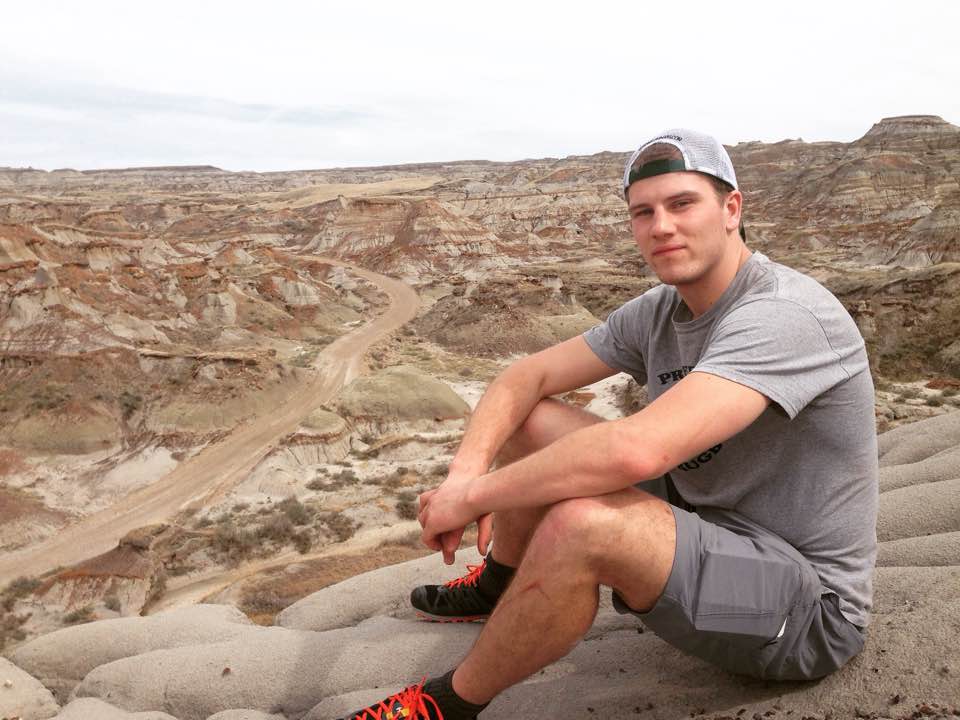
At the event, the winners of the student-selected Lusby and Cameron awards were released. Winner of the Harcourt Cameron Award in Geology is Dillon Langelaan, shown here as he received the award from Dr. Spooner. Winner of the Linda Lusby Award in Environmental Science is Grace Hamilton-Burge, but her commitments as incoming ASU President meant she had to be elsewhere this evening.
Thanks to all who helped make an enjoyable evening. Now, back to the books?
Conference Season and Environmental Research at Acadia
27 March 2017
In late winter and early spring, the thoughts of 4th year Honours students turn to ... thesis writing and conferences!
Attending conferences provides students with an opportunity to add an important experience to their CV, polish their presentation skills, learn about other research on campus, and for those attending off-campus conferences, the opportunity to check out other labs and potential supervisors for graduate work.
Biofeedback 2017 - The 24th Annual Undergraduate Biology Research Conference - Feb 22 and 24.
Environmental Science students with a biological bent often present their research to the Biology department and the university community at Biofeedback, Acadia’s Biology Undergraduate Research Conference. Biofeedback is normally held in the KC Irving Environmental Science Centre Auditorium, usually on the Wed and Thursday in the week preceding spring break.
This year Biofeedback week got off to a rough start with classes being cancelled and the university closed on both Monday and Tuesday because of a howling blizzard. Nevertheless, the conference got underway on Wednesday with only a minor glitch, i.e. no printed programs. Unfortunately, Thursday produced yet another storm, this time a nor'easter that dumped "only" 30 cm of snow, but managed to shut down the university for the third day in one week! Some quick re-organizing allowed the conference to re-convene on Friday.
Two Environmental Science students presenting their Honours research along with many Biology students this year. While it is not required as part of their degree, Environmental Science students working with a professor in Biology can choose to present at Biofeedback if they wish. Despite the interference of mother nature, the student presentations at Biofeedback were remarkable, with several conference attendees marvelling that both the quality of research and the quality of presentations seem to get better every year.
The projects included:
Reintroduction of Seed Bank Derived Geum Peckii (Eastern Mountain Avens) on Long Island, Digby County, Nova Scotia by Sarah Fancy (ENVS and Arthur Irving Scholar);
Comparative genetic analysis of Crocanthemum canadense (L) Michx, plants of known pedigree (chasmogamous- or cleistogamous-derived seeds) using amplified fragment length polymorphisms (AFLPs) by Erica Gillis.
In addition, one of the Environmental Science honours students, Bryanna Sherbo, presented at the 4th Annual Student Research and Innovation Conference on March 3 and 4. Her poster was entitled "Are polar bears and hunters competing for the same seals near Churchill, Manitoba?" and presented the results of her thesis and summer work in Churchill.
Bryanna Sherbo discussing her poster at the Student Research Conference.
[Further details can be found on the KC Irving Environmental Science Centre page.]
Acadia Environment program highlighted by Macleans
20 March 2017
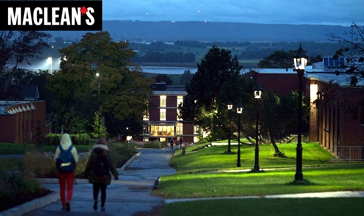
The latest universities issue of Macleans contains a profile of Acadia University, which identifies one of the strengths as its environmental programs: "The environmental science program lets students approach issues from a scientific perspective, while the environmental and sustainability studies program looks at environmental policy." It also picks out Nelson O'Driscoll's ENVS4613 course, Contaminants in the Environment where students can "study the history of chemicals released into the environment and the effects they have on ecosystems, as well as methods of assessing ecological risk" as one of the cool courses available here. We completely agree!
Read the full article.
CFI Funding awarded to Peir Pufahl
1 March 2017
Canadian researchers received a $50 million boost from the Government of Canada on 28 February for the cutting-edge tools they need to keep Canada at the forefront of innovation. Acadia University professor Dr. Peir Pufahl will receive $201,036 from the Canada Foundation for Innovation’s John R. Evans Leaders Fund which helps institutions compete internationally in their priority research areas and is an important strategic investment tool designed to help institutions attract and retain the very best of today’s and tomorrow’s researchers.
“I want to congratulate Dr. Pufahl on his success securing funding from the John R. Evans Leaders Fund,” said Dr. David MacKinnon, Acadia’s Dean of Research and Graduate Studies. “This is the largest infrastructure award ever received by our Department of Earth and Environmental Science and demonstrates the capacity within our faculty to perform research that is truly on a world scale.”
This funding is combined with $201,036 from the Nova Scotia Research Investment Trust and $100,518 from private and institutional donors for a total investment of $502,590. Together, this funding enhances the capability of Pufahl’s Petrogenesis Laboratory for Sedimentary Ore Deposits that is focused on phosphorite research. The new infrastructure (a state-of-the-art X-ray diffractometer (XRD), fume hood and lab renovations) will allow the facility to improve the characterization and interpretation of the genesis and evolution of economic phosphorite.
“This infrastructure is vital to enhancing opportunities for collaborative research as well as establishing Acadia and Canada as a leader in phosphorite research,” said Pufahl. “The location of this lab, in our renewed Huggins Science Hall fits perfectly with Acadia’s expanding capacity in agri-technology research. The infrastructure investments from the federal and provincial governments, combined with the private support received from alumni and others, are important boosts for our faculty and students.”
Pufahl is is one of the top two or three experts globally who understand the economic geology of phosphate, a key ingredient in fertilizer, and is a member of the team under Dr. Nicolas Tosca, of Oxford University, that was awarded $1 million in 2015 by the UK’s Natural Environmental Research Council (NERC) for a multi-year project to investigate the evolution of the primitive Earth.
“Investments in Canada’s research infrastructure, like those we are celebrating today, are incredibly important to our nation’s future,” said the Honourable Kirsty Duncan, Minister of Science. “They help us to attract and retain the very best scientists and give Canadian researchers the tools they need to perform excellent cutting-edge research, train the scientists of tomorrow and enable innovative new discoveries that improve our environment, economy and communities.”
For 20 years, the CFI has been giving researchers the tools they need to think big and innovate. And a robust innovation system translates into jobs and new enterprises, better health, cleaner environments and, ultimately, vibrant communities. By investing in state-of-the-art facilities and equipment in Canada’s universities, colleges, research hospitals and non-profit research institutions, the CFI also helps to attract and retain the world’s top talent, to train the next generation of researchers and to support world-class research that strengthens the economy and improves the quality of life for all Canadians. The John R. Evans Leaders Fund helps a select number of exceptional researchers at institutions across the country to conduct leading-edge research by giving them the research tools and equipment they need to be or become leaders in their field.
Acadia grad aiming for space
18 February 2017
Crystal LaFlamme, a geoscientist who got her BSc (Honours) from Acadia University in 2007 and her PhD from the University of New Brunswick in 2014, is in the running to become one of two new astronauts with the Canadian Space Agency.
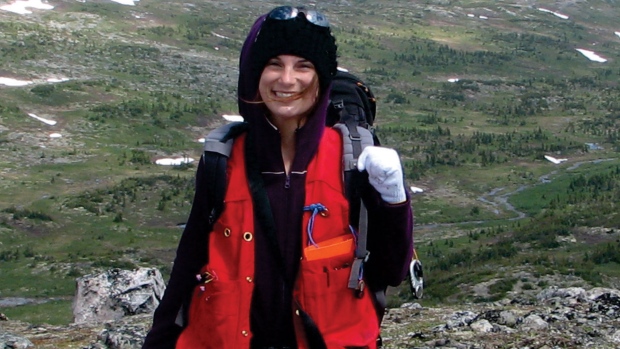
What was initially a last-minute application for the position has turned into a gruelling competition over the past few months. So far, the former Acadia student has survived three rounds of cuts and is one of 72 people shortlisted by the agency.
Crystal wrote "I immediately felt both nervous and excited. Mine was a last–second application. I just had no idea that I met the fundamental requirements. To be part of the top 72 is really exciting. If I am selected, I'll be terrified, nervous, excited — a multitude of emotions will run through me."
Crystal completed her honours BSc degree, studying mineral deposits in Flin Flon, Manitoba, and has subsequently achieved her MSc and PhD degrees from MUN and UNB, working on rocks in Nunavut. Today, she is a research fellow with the University of Western Australia, working with a team of geoscientists studying how the Earth's crust formed and evolved over billions of years.
More details at http://www.cbc.ca/news/canada/new-brunswick/astronaut-space-agency-crystal-laflamme-unb-1.3985863
Acadia participation at AGS Colloquium
15 February 2017
Fourteen students and four professors from Acadia traveled to Fredericton on 10-12 February to participate in the 43rd annual Atlantic Geoscience Society colloquium and annual meeting. The AGS colloquium was attended by 166 delegates and included over 100 papers and posters, several by Acadia students and faculty.
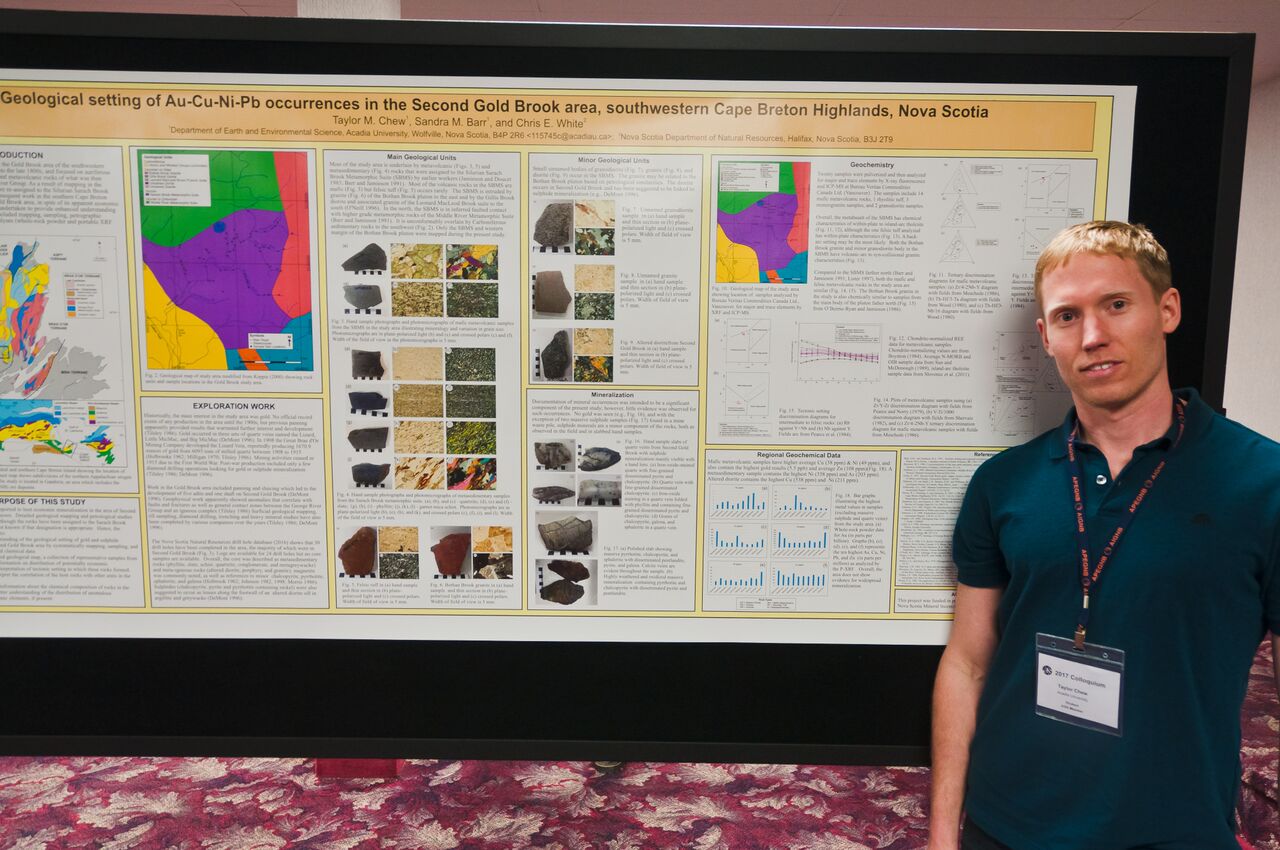
Taylor Chew displaying his poster on the Second Gold Brook gold deposit, Cape Breton Island.
Also in the program was a special sessions on "The Northern Appalachians: Correlations and Conundrums", organized by Sandra Barr, Travis McCarron, Deanne van Rooyen and Chris White, which attracted 11 papers, two co-authored by Sandra Barr.
Graduate student Jonathan Shute also gave a paper in the "Education, Integration and Development of Earth Science for Social Benefit" session, entitled Tied to the Earth: communicating geoscience in an adventurous, aesthetic and anthropocentric manner" and a poster on the work of his Masters thesis in western Cape Breton Island.

Stephanie Todd presented with co-authors Peir Pufahl, Brendan Murphy and Kevin Taylor on "Sedimentology and Oceanography of Early Ordovician ironstone, Bell Island, Newfoundland", for which she received the Sandra Barr Award for best oral presentation by a graduate student. She is seen here receiving the award from Rob Raeside, secretary of the Society.
Rupert MacNeill Book Prize recipients
9 January 2017
Dillon Langelaan and Simon Poirier were recently awarded the Rupert MacNeill book prize by the Wolfville Rotary Club. The prize was established in 1983 in memory of Rupert MacNeill, professor of Geology at Acadia University. Rupert was also very active in the local Rotary Club, who established this award in his memory. Both students are seen here receiving the prize from Dr. Cliff Stanley, also a member of the Rotary Club.

Dillon Langelaan (left image) was the 2016 recipient. Dillon is from Aylesford, NS, and is working on his honours thesis with Dr. Cliff Stanley on the chemistry of solvents used to dissolve soils in mineral exploration. Simon Poirier (right image) is from Dartmouth, NS, and is finishing his thesis on the geology of Cu-Au-Pb-Zn occurrences in the Rocky Brook area, western Cape Breton Island, Nova Scotia, supervised by Dr. Sandra Barr.

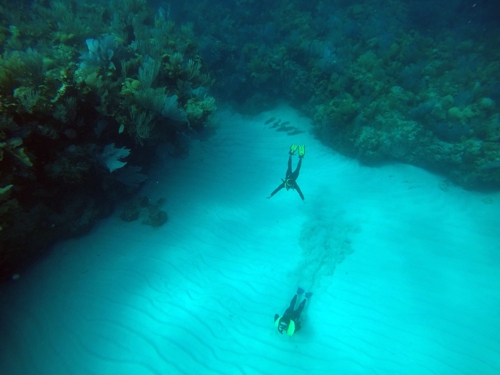
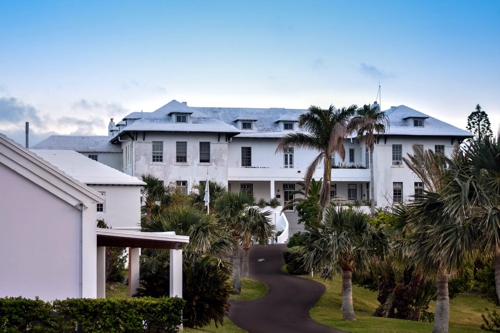 Bermuda Institute of Ocean Sciences (image by Reid Cameron)
Bermuda Institute of Ocean Sciences (image by Reid Cameron)